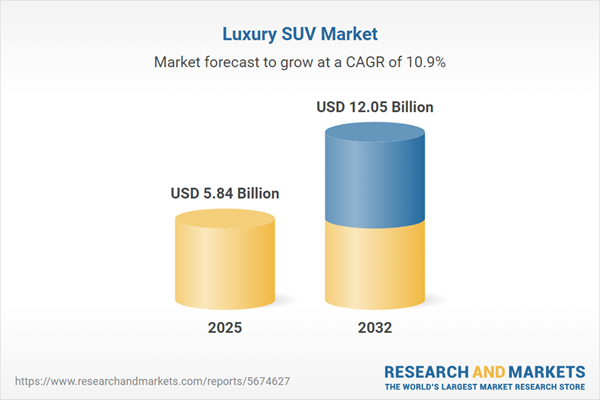Speak directly to the analyst to clarify any post sales queries you may have.
The luxury SUV market is experiencing significant transformation, fueled by evolving buyer expectations, regulatory developments, and increasing digitalization. Top decision-makers need precise and actionable insights to adapt strategies, capture growth opportunities, and remain competitive in a complex, rapidly changing sector.
Market Snapshot: Luxury SUV Market Size & Growth
The global luxury SUV market is projected to expand from USD 5.26 billion in 2024 to USD 5.84 billion in 2025, ultimately reaching USD 12.05 billion by 2032, representing a compound annual growth rate (CAGR) of 10.90%. This upward trajectory reflects industry-wide adoption of digital sales channels, advances in vehicle technology, and resilient supply chain dynamics. Both established automotive leaders and new market entrants are capitalizing on demand trends across diverse global economies. Organizations succeeding in this environment are those able to anticipate shifts in regulatory and technology landscapes, adjusting business models to sustain long-term performance.
Scope & Comprehensive Segmentation
- Distribution Channels: Direct dealership networks and evolving online sales platforms are broadening market access, supporting omnichannel approaches that enhance customer engagement and sales outcomes worldwide.
- End Users: Corporate fleet operators prioritize operational efficiency and sustainable practices, while individual consumers value advanced customization and integrated features. Rental fleets demand vehicle durability and high lifecycle returns.
- Seating Capacities: The market offers compact through large models, accommodating urban use, family transportation, and multi-purpose applications with versatile interior configurations.
- Powertrain Technologies: Diesel, petrol, hybrid, and electric powertrains enable manufacturers to address diverse performance and sustainability goals, supporting transitions to more sustainable mobility and compliance with global policies.
- Engine Displacement: Luxury SUVs span sub-2.0L engines focused on fuel efficiency up to models above 3.0L providing enhanced power, allowing for a broad spectrum of operational needs and customer preferences.
- Price Range: Entry-level models attract first-time buyers seeking luxury experiences, while upper-tier models cater to established clients looking for exclusivity and premium features.
- Geographic Coverage: The report analyzes market trends and regulatory environments across the Americas, Europe, Middle East, Africa, and Asia Pacific. Specific focus is placed on pivotal markets such as the US, Germany, China, India, Japan, UAE, and Australia, each with unique drivers and challenges that influence local demand and competitive strategies.
- Representative Companies: Key participants include Mercedes-Benz Group AG, BMW AG, Audi AG, Toyota Motor Corporation, Jaguar Land Rover, Volvo Car Corporation, Porsche AG, Tesla Inc., General Motors Company, and Honda Motor Co., Ltd. These leading firms shape innovation and competition through strategic investments and continuously evolving product portfolios.
Key Takeaways for Decision-Makers
- Rising digital connectivity and the push for electrification are transforming customer journeys, requiring integration of next-generation technologies to sustain brand relevance and foster loyalty.
- Flexible vehicle designs are broadening the luxury SUV segment’s appeal, enabling manufacturers to address evolving consumer lifestyles and diverse usage scenarios.
- Progress in driver assistance systems, advanced infotainment, and software-enabled vehicle updates differentiates premium brands and aligns with heightened consumer expectations.
- Organizations that strengthen operational resilience through adaptive production planning and diversified supply chains are better positioned to navigate ongoing volatility and regulatory complexity in global markets.
- Innovative sales models, including digital-first platforms and subscription-based services, are altering purchasing behavior, expanding access, and supporting market penetration worldwide.
- Pursuing strategic alliances with technology and mobility partners accelerates product innovation and secures a competitive edge in the evolving luxury SUV marketplace.
Tariff Impact and Strategic Adaptation
Changes to U.S. automotive trade tariffs are prompting manufacturers to reassess global sourcing, production, and pricing structures. Companies are responding by localizing operations, strengthening partnerships across industry sectors, and enhancing stakeholder engagement. Adapting value chains is increasingly vital for resilience against geopolitical, regulatory, and supply chain disruptions.
Methodology & Data Sources
This research utilizes primary interviews with senior industry and supply chain leaders, complemented by corporate reporting and pertinent regulatory documents. Analytical modeling and scenario analysis support delivery of relevant and accurate market insights.
Why This Report Matters
- Facilitates targeted segment and regional analysis to inform market entry, timing, and investment strategies in the luxury SUV market.
- Reveals pivotal technological and regulatory trends, guiding decision-makers in realigning strategies and developing targeted partnerships.
- Supports responsive risk management with dependable data on industry volatility and emerging macroeconomic influences.
Conclusion
This report empowers senior leaders to confidently define strategies and operational plans for a demanding luxury SUV market, providing timely intelligence for effective, agile decision-making.
Additional Product Information:
- Purchase of this report includes 1 year online access with quarterly updates.
- This report can be updated on request. Please contact our Customer Experience team using the Ask a Question widget on our website.
Table of Contents
3. Executive Summary
4. Market Overview
7. Cumulative Impact of Artificial Intelligence 2025
List of Figures
Samples

LOADING...
Companies Mentioned
The key companies profiled in this Luxury SUV market report include:- Mercedes-Benz Group AG
- Bayerische Motoren Werke Aktiengesellschaft
- Audi AG
- Toyota Motor Corporation
- Jaguar Land Rover Limited
- Volvo Car Corporation
- Porsche AG
- Tesla, Inc.
- General Motors Company
- Honda Motor Co., Ltd
Table Information
| Report Attribute | Details |
|---|---|
| No. of Pages | 184 |
| Published | October 2025 |
| Forecast Period | 2025 - 2032 |
| Estimated Market Value ( USD | $ 5.84 Billion |
| Forecasted Market Value ( USD | $ 12.05 Billion |
| Compound Annual Growth Rate | 10.9% |
| Regions Covered | Global |
| No. of Companies Mentioned | 11 |









